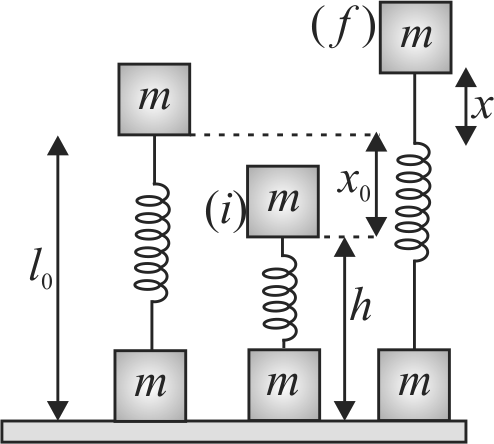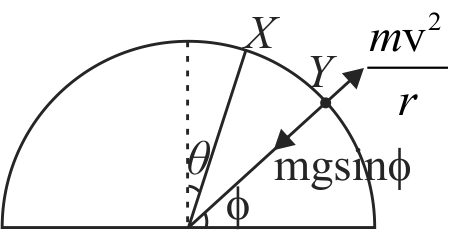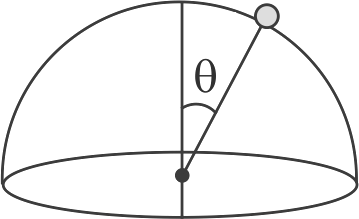355338
A system consists of two identical cubes, each of mass \(m\), linked together by a compressed weightless spring of force constant \(k\). The cubes are also connected by a thread which burnt at a certain moment. The minimum value of initial compression \(x_{0}\) of the spring for which lower cube bounce after the thread is burnt is: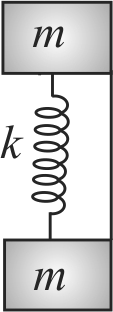
355339
A particle is released on a vertical smooth semicircular track from point \(\mathrm{X}\) so that \(\mathrm{OX}\) makes angle \(\theta\) from the vertical (see figure). The normal reaction of the track on the particle vanishes at point \(\mathrm{Y}\) where OY makes angle \(\phi\) with the horizontal. Then :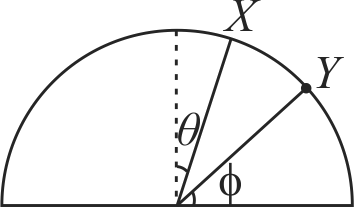
355338
A system consists of two identical cubes, each of mass \(m\), linked together by a compressed weightless spring of force constant \(k\). The cubes are also connected by a thread which burnt at a certain moment. The minimum value of initial compression \(x_{0}\) of the spring for which lower cube bounce after the thread is burnt is:
355339
A particle is released on a vertical smooth semicircular track from point \(\mathrm{X}\) so that \(\mathrm{OX}\) makes angle \(\theta\) from the vertical (see figure). The normal reaction of the track on the particle vanishes at point \(\mathrm{Y}\) where OY makes angle \(\phi\) with the horizontal. Then :
355338
A system consists of two identical cubes, each of mass \(m\), linked together by a compressed weightless spring of force constant \(k\). The cubes are also connected by a thread which burnt at a certain moment. The minimum value of initial compression \(x_{0}\) of the spring for which lower cube bounce after the thread is burnt is:
355339
A particle is released on a vertical smooth semicircular track from point \(\mathrm{X}\) so that \(\mathrm{OX}\) makes angle \(\theta\) from the vertical (see figure). The normal reaction of the track on the particle vanishes at point \(\mathrm{Y}\) where OY makes angle \(\phi\) with the horizontal. Then :
355338
A system consists of two identical cubes, each of mass \(m\), linked together by a compressed weightless spring of force constant \(k\). The cubes are also connected by a thread which burnt at a certain moment. The minimum value of initial compression \(x_{0}\) of the spring for which lower cube bounce after the thread is burnt is:
355339
A particle is released on a vertical smooth semicircular track from point \(\mathrm{X}\) so that \(\mathrm{OX}\) makes angle \(\theta\) from the vertical (see figure). The normal reaction of the track on the particle vanishes at point \(\mathrm{Y}\) where OY makes angle \(\phi\) with the horizontal. Then :
355338
A system consists of two identical cubes, each of mass \(m\), linked together by a compressed weightless spring of force constant \(k\). The cubes are also connected by a thread which burnt at a certain moment. The minimum value of initial compression \(x_{0}\) of the spring for which lower cube bounce after the thread is burnt is:
355339
A particle is released on a vertical smooth semicircular track from point \(\mathrm{X}\) so that \(\mathrm{OX}\) makes angle \(\theta\) from the vertical (see figure). The normal reaction of the track on the particle vanishes at point \(\mathrm{Y}\) where OY makes angle \(\phi\) with the horizontal. Then :
